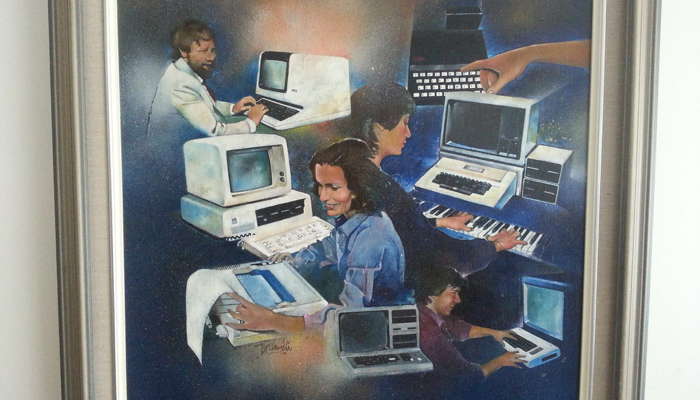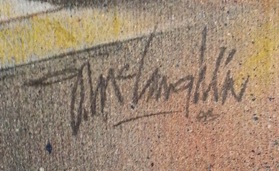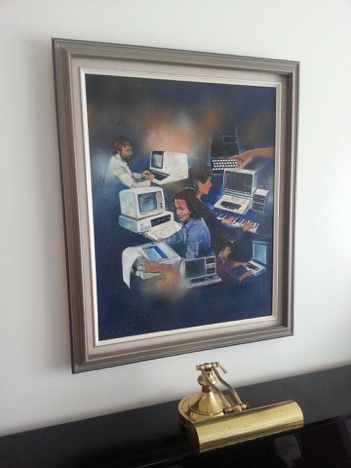The dawn of personal computing

If you know me, or have read various sections of my website, you’ll know that I am a die hard member of the computing industry that also likes to collect vintage computers (this is actually quite common - you’d be surprised how many of my colleagues do the same).

Yesterday, I managed to find a very interesting canvas painting in Toronto (the picture at the top of this post), and just HAD to have it. From the signature, it was painted in 1983 by what looks like T., N., or M. McLaughlin:
Unfortunately, it is untitled. But since it is professionally framed, perhaps the title was on a metal plate below the painting where it was hung.
Nonetheless, a perfect title came to me the moment I saw it: The dawn of personal computing. Not only does it showcase many of the key personal computers of the early 80s, it also depicts how people often used them at the time.
The computers in the painting clockwise starting from the upper left are:
- DEC Robin
- Sinclair ZX-81
- Apple II
- Commodore VIC-20
- Tandy TRS-80 Model III
- IBM PC 5150
Digital Equipment Corporation (DEC) was a legend in the very early computer industry as they made most of the larger computer systems that were used on the early Internet by universities and science/engineering companies. The DEC Robin (a.k.a. DEC VT-180) was DEC’s foray into personal computing. They took the same case and hardware that they used for their famous VT-100 terminal (which allowed you to interact with a larger DEC computer) and made it into a standalone personal computer that had a Zilog Z80 CPU. It ran the CP/M operating system that was very common in the 80s, especially for business use, due to the large number of business applications available for it.
The Sinclair ZX-81 was the smallest personal computer of the 80s - it was designed to be inexpensive so that most people could buy one. They were less than $100, had a Zilog Z80 CPU, and connected easily to your TV for use (monochrome output only). Although it only had 1KB of RAM, you could get a 16KB expansion pack that stuck out of the back vertically (which is also depicted in the painting if you look closely).
The Apple II was one of the first personal computers that was easy to use. Apple released new models of the Apple II every few years since its debut in 1977 (all based on the MOS 6502 CPU), and it remained one of most popular personal computers until the late 80s. This was largely due to its several expansion ports that allowed manufacturers to make a wide variety of expansion cards and peripheral devices that could plug into the computer. The painting shows an Apple II computer with a monitor, two floppy disk drives, and an alphaSyntauri music synthesizer keyboard that connected to the Apple II via an expansion card. Even Emerson, Lake & Palmer used an alphaSyntauri and Apple II in many of their performances!
In the 70s and 80s, Commodore was a legend in the personal computer industry, because they were the most popular. The Commodore VIC-20 shown in the painting was the first computer to sell 1 million units, and its successor (the Commodore 64) was the best selling computer of all time (still today!). They were incredibly powerful and affordable compared to other personal computers at the time (although not nearly as inexpensive as the Sinclair ZX-81), and were based on the same MOS 6502 CPU that Apple computers used. Because of Commodore’s popularity, there were more software programs made for Commodore computers than any other brand, including games. And judging from the expression on the face of the guy in the painting, he’s probably playing a game on his VIC-20.
If you bought a computer from Radio Shack in the 80s, it was likely a Tandy TRS-80 computer (with a Zilog Z80 CPU) because Tandy was the company that owned Radio Shack. Due to the sheer number of Radio Shack stores, Tandy TRS-80 computers were more popular than Apple computers, and the Tandy TRS-80 Model III shown in the painting was one of the most popular models. However, there were far fewer software applications available for Tandy computers compared to Apple or Commodore, and the TRS-80 line of computers faded into history by the late 80s.
The last computer depicted on the painting is the infamous IBM PC 5150 (the first “IBM PC”). Like DEC, IBM was a legend in the early computer industry - they built large mainframe computers for business use, and the IBM PC 5150 (with an Intel 8088 CPU) was their foray into the personal computer market. It was expensive, had very few applications, and wasn’t designed for playing games or making music like Commodore and Apple computers. About all you could do with it was word processing, run business applications (e.g. spreadsheets) and print the results of your efforts (much like the lady in the painting). But IBM was a powerful name……and during the 80s, other manufacturers started making IBM PC-compatible computers in large numbers, while Microsoft released newer DOS and Windows operating systems for them. By the early 90s, it was clear that the “IBM PC” was the dominant personal computer, with Apple’s Macintosh computer line (the successor to the Apple II line) trailing behind. Oh, and by the way, today happens to be the 35th anniversary of the IBM PC 5150 computer (released August 12th, 1981).

Now that we’ve examined the computers in the painting, let’s look at the big picture (so to say). This painting has a wealth of history in it - but more importantly, it reflects the humble beginnings of personal computing and the personal computing industry in the early 80s.
By 1980, everyone knew that computers could be had by regular people. It was a time of technological optimism and innovation, and the number of personal computer manufacturers was diverse….each one with their own visions for what a personal computer should be. Sinclair thought they should be incredibly inexpensive, Apple thought they should be expandable, IBM thought they’d be used for productivity, and so on.
Only two companies from that time survived to the present day: Apple, which is now the largest technology company in the world, and IBM, which is one of the largest producers of business software in the world (they sold off all of their hardware divisions by 2014). And what about the technological optimism and innovation regarding personal computers? Well, it’s still here of course, but the definition of personal computer has shifted slightly……the bleeding edge of “personal” computing today is with mobile devices ;-)
The computing industry in general is one of the richest when it comes to progress. Its history is colourful, and new technologies are made all the time, by those who have their own views of how technology can augment our lives.
And to keep it all in perspective, it’s nice to reflect on how far we’ve come since the dawn of personal computing nearly 40 years ago. For me, I simply need to look at the painting above the piano in my living room.